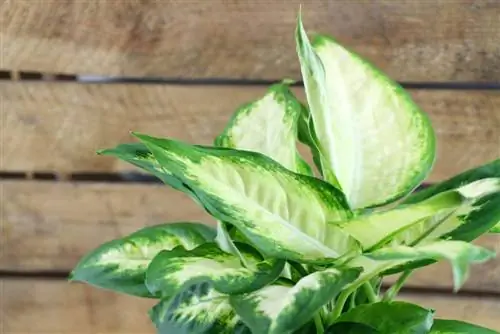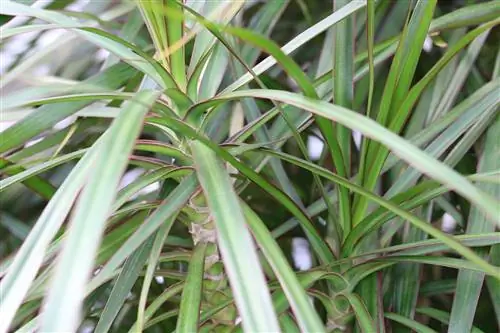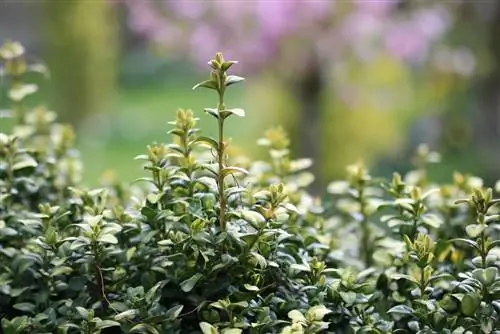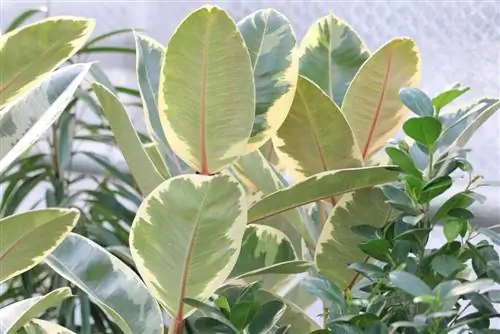- Author admin [email protected].
- Public 2023-12-17 03:39.
- Last modified 2025-01-24 12:45.
There are some plants that are considered poisonous and therefore dangerous to humans and animals. This also includes a very decorative houseplant, the Dieffenbachia. Even just touching it can cause symptoms of poisoning and the leaking water is also poisonous, which can be fatal, especially for pets such as cats or dogs. If you still want to cultivate the houseplant in your home, you should take a few precautionary measures, especially if there are small children or cats and dogs in the household.
Characteristics of Dieffenbachia
The decorative houseplant is available in many types. But all of them are characterized above all by their leaves decorated with patterns in yellow or white. It can reach up to 1.50 meters in size. Some species have very large leaves, others have long, narrow leaves. All parts of the houseplant are poisonous. The petiole, leaves and the shoot axis contain the poison, which can be dangerous for humans and animals. The draining water also contains the poison and therefore special care should be taken here, for example if the saucer has to be drained. But it's not just oral intake that's unhe althy; touching the plant can also have a bad effect. Because the following happens when you touch it:
- the plant opens shooting cells when touched
- toxins and needles are shot out of this
- these can hit and injure skin or eyes
Tip:
The plant owner himself should also approach his Dieffenbachia with extreme caution. Gloves, long sleeves and face protection should always be worn when it comes to caring for your graceful beauty.
Containing poisons
There are various poisons in Dieffenbachia and it is precisely this mix that makes the plant so dangerous for people and pets. It contains the following poisons:
- Oxalic acid and calcium oxalate crystals damage kidneys and mucous membranes
- Alkaloids
- Trigloquinine
- Saponin
Protect children
Children in particular, who touch everything, are more at risk from the toxicity of Dieffenbachia than is the case with adults. It is therefore important that children are not allowed to come into contact with the plant. If you have small children, you may want to avoid cultivating Dieffenbachia. If you still want the plant to find a place in your own home, you should act as follows:
- only set up in a room that is locked and where children cannot get in
- Place as high as possible on a shelf or hang from the ceiling as a hanging basket
- Window sill is not a well-chosen location, as some children's hands can reach here
- Always make sure that children living in the household are not tempted to touch the plant
Tip:
If the children in the household are older, they can be made aware of the dangers that could arise from touching the plant. Schoolchildren from around the age of ten understand the danger and comply with it.
Protect pets
The situation with pets is similar to that with children; they are usually even more at risk. Because dogs or cats cannot be forbidden from touching the plant. In addition, the animals like to drink the water that has leaked from all plants, which in this case would be bad for them. If you have pets in the household, you should definitely pay attention to the following:
- If possible, avoid Dieffenbachia if there are animals in the household
- otherwise the plant can be placed high up or placed around dogs, guinea pigs or rabbits
- Cats, which can also climb, should never be in the same room with the plant
- Birds such as budgies or other species that have the opportunity to fly freely in space should not receive Dieffenbachia as an approach destination
Symptoms of poisoning in people and animals
There are two different types of poisoning symptoms. This depends on whether the poisoning came from contact or whether individual parts of the plant were put in the mouth and possibly swallowed.
The following symptoms occur when poisoning by touch:
- Skin or eye irritation as the plant releases the poison
- Eyes can become inflamed or the conjunctiva can be burned by the poison shot
- recognizable by cramped eyelids or heavy flow of tears
- large water bubbles or pustules form on the skin
When taken through the mouth it comes to:
- Swelling, redness or burning in the area of the mucous membranes and tongue
- Speaking and swallowing are difficult for those affected
- Diarrhea and nausea as well as vomiting
- Daziness
- Paralysis
- Cardiac arrhythmias
Tip:
If you can't always be in a room with a plant and your children or animals, you won't realize until much later that it could be poisoning. In the worst case, smaller pets, but also dogs and cats, can die from the dieffenbachia poison they ingest.
First measures
If one or more symptoms appear, action must be taken immediately. If the person or animal in question has come into contact with the plant, in mild cases the affected areas can be washed with water. In severe cases, call the emergency number at 112 or the local animal emergency number. Nobody should be afraid here, because this precautionary measure should not be omitted. If part of the plant has been ingested through the mouth and even swallowed, initial measures should be taken:
- Immediately remove any plant residue that is still in the mouth
- if necessary, rinse your mouth so that everything is completely removed
- only then, when there are no more plant parts in the mouth, offer liquid for consumption
- definitely avoid milk, as it can increase the absorption of poison
- Medicinal charcoal powder can also be administered, which binds the poisons in the stomach
- Then you should immediately call the emergency number for people or animals
- Because of their body size and weight, the animals are at greater risk of dying from Dieffenbachia poison
Conclusion
The Dieffenbachia is a very decorative houseplant for all singles or couples who live without children or pets. If there are small children or animals in the household, then you should avoid purchasing the beautiful, evergreen plant with the large, patterned leaves, as difficult as it may be. However, if you don't want this, you should take some precautions so that children or pets cannot reach the plant. Even just touching it can have a big impact. The adult owners of the plant themselves also need to be extremely careful with the graceful beauty so as not to be affected by poisoning themselves.






